AEM Vs Drupal, Which is Preferable for Enterprise Users?
Category: Adobe Experience Manager (AEM) Posted:May 20, 2020 By: Ashley Morrison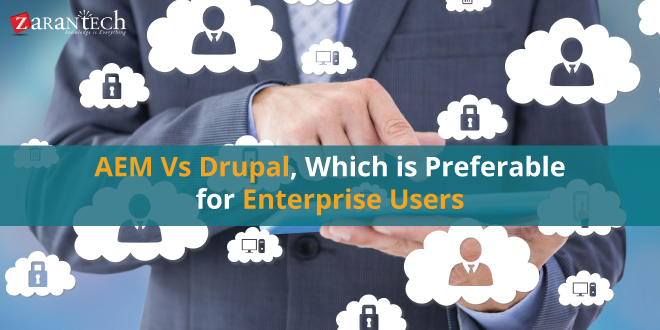
The breakthrough in technology and the ubiquitous need for delivering customized web content have made it pivotal for firms to accept the web content management system for all the right reasons. It begins from engaging customers, to lead generation, to snowballing total profits from different systems.
Nevertheless, it can be daunting and tricky sometimes for businesses to choose the appropriate one as per their requirements based on the diverse features and potential CMS offers.
One of the prominent reports by Gartner states that the Web Content Management Magic Quadrant report has proclaimed that Acquia Drupal, Adobe Experience Manager, and Sitecore are the three most prominent WCM Managers.
These three are at the forefront in Gartner’s report based on the two variables majorly, “ability to implement”, and “completeness of vision”. They undoubtedly outmatched both these parameters and hence it does without stating that all three excel in satisfying enterprises’ WCM needs.
Nonetheless, as one size does not fit all and there can be multiple parameters contrasting these, it’s far better to mainly group them into various stakeholder viewpoints- the business decision-makers, the material and marketing teams, and the IT groups. Each of these interplay a crucial duty in the process.
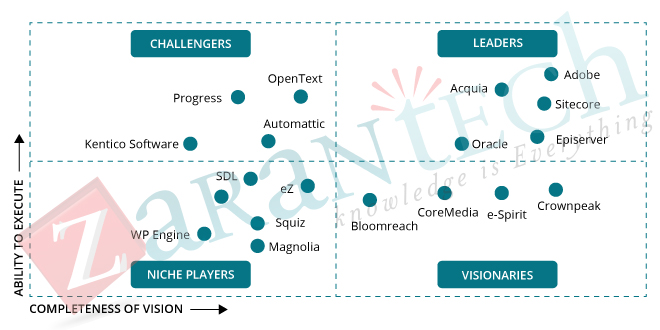
The content, advertising and marketing, and IT team will be the ones directly working with the CMS they choose. Business decision-makers, CIO, CTO, and Chief Data Officer (CDO) are the ones who will certainly be held accountable for their options and showcasing appropriate ROI.
This blog will deal with the comparison of AEM and Drupal from the viewpoint of business decision-makers. Here we’ll mostly focus on aspects like the price of application, scalability, security, and maintenance to see exactly how Drupal and AEM fare against each other.
Click here to know more
Choose What’s Best For You to Learn
Recognizing your business demand should be the first job on your to-do list. This will assist you as a decision-maker to draw the verdict.
Cost of Implementation
“A high rate might be a part of its charisma in selling difficult art”, quoted by Robert Genn, a renowned Canadian musician.
You need to obtain the preferred outcome for the price you spend for a CMS.
Establishing any kind of huge modern technology option is always an attractive inquiry as it entails the price associated with it for implementation. Though it is justified that CMS creates a framework for enterprise technology architecture, and leads the way for transformation; the expenditure made on this is yet always under evaluation.
“Being pricey doesn’t make CMS complete or competent enough for the business”
Furthermore, migrating to brand-new CMS is a difficult task for any kind of enterprise IT team. So, this important decision of investing in any type of specific CMS is made after several rounds of consideration. And once deployed, organizations end up being incredibly perceptive of adjusting to a change.
The objective behind all such discussions is to get this done right for the very first time & the investment and ROI of any type of particular enterprise CMS is one of the greatest elements to take into consideration.
Licensing Charges
The first and foremost difference between AEM and Drupal is their nature of accessibility- AEM is proprietary while Drupal is open-source. AEM’s licensing cost is approximately 40,000 USD, with additional cost implications based on organizations’ size and expected usage. This is not a single investment. It is a repeating expenditure every year.
On the other hand, Drupal is an open-source system and hence disposes of any type of licensing charge.
Build vs. Buy
The way the present market trends are soaring does not enable enterprises to take into consideration the implementation of CMS, a good suggestion as it will certainly consume a substantial amount of time. Their assumptions lie in learning a unique and cutting-edge service that is easily offered with the quick installation process and training for content, advertising, and larger digital experience teams to run full-fledged campaigns.
The basic perception that surfaces with Drupal being an open-source, developer-driven option, is the demand of a completely professional team to release it. There is a definite apprehension around the fact that enterprises have to develop from scratch to establish a Drupal CMS, which without second thoughts, consumes a lot of time, resources, and money.
AEM is regarded as a ready-to-use product needing marginal expert setup.
Nonetheless, it’s extremely important to apprehend that build vs. buy discussion is not as simple as it shows up.
Because, In contrast to the presumption, Drupal does have more than 20,000 modules and distributions that give on-the-go performances and functions like multisite, multilingual, dynamic content, customization, and more. With distribution like Acquia Lightning, Drupal caters to extremely targeted, easy-to-implement enterprise-level content management solutions, unlike AEM.
The other notable point is that AEM does require specialized teams for layout, organizing, and maintaining an effective digital platform. They demand an almost similar degree of a build like that of Drupal. But here also, the overall price of application for Drupal would certainly be around 250,000 USD to 350,000 USD on an average, and around 500,000 USD if you compute hosting also. On the other hand, a typical AEM application spending plan starts exceeding the limit of 500, 000 USD and can go as high as 1 million USD.
Support & Maintenance
Both Drupal and AEM need significant maintenance post-deployment.
About the maintenance, Drupal will certainly secure your content yet to lay the base for the modern architecture it won’t think twice from breaking some components to guarantee that the platform is up-to-date and relevant. To accomplish this task, it will get rid of unwanted bloatware related to a rote adherence to backward compatibility.
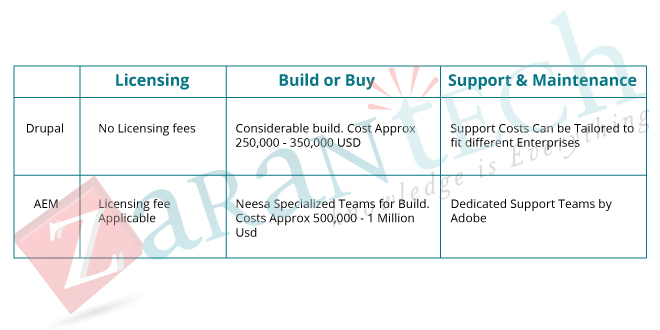
Security
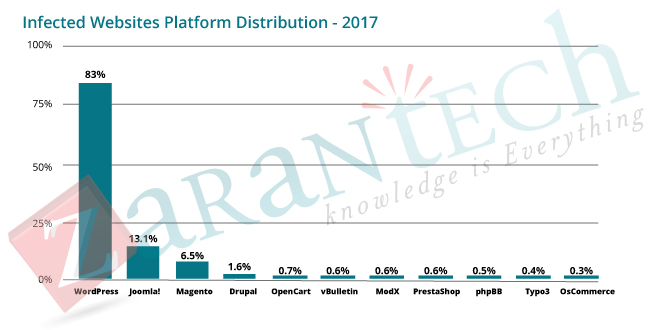
AEM is a secured platform with predefined functionalities to guarantee security and management. Individual recognition, and accessibility, can be quickly managed. There are tried-and-tested strategies by which the threat of inter-site request forgery can be minimized, and the third party data storage space, and role-based authentication and access to data can be successfully protected.
According to the stats, Drupal does far better than various other leading CMS platforms in regards to shielding sites from any kind of exterior threats.
Sucuri, safety platform websites, assembled the Hacked Internet site report, evaluated greater than 34,000 contaminated websites. Among the statistics that it shared, one of the elements impacted was an open-source CMS application.
The infection crippled other CMS due to incorrect implementation, configuration, and inadequate maintenance.
With Drupal being an open-source system, it is usually presumed less safe in comparison to an exclusive platform like AEM. Nevertheless, that’s not the case!
Drupal has practically similar security and governance features embedded within it comparable to AEM. Drupal has dedicated components for recognition, authentication, and access-based controls.
“Drupal’s security standards are established by the Open Web Protection Task, making it secure deliberately”
The database encryption at various degrees vouches for data security to make sure that no unauthenticated user can breach the protection. Likewise, there is a built-in safety reporting function to allow groups to highlight and raise the security problems within the community.
It is to be noted that AEM’s security effort is led only by one team, with Adobe providing support whenever essential.
However Drupal has a different story to tell! The security advisory not only works to safeguard the platform but also ensures that there are numerous touchpoints to resolve the concern.
Security documentation, helps programmers create safe code, and maintain modules for added security- all this creates a bigger system that continuously safeguards Drupal. Its safety requirements are set by the Open Web Protection Task, making it secure by design.
Click here to learn more about AEM
Scalability and Future Proofing
CMS lays the foundation for providing the one-of-a-kind digital experience to users so it should be scalable as well as personalized. It should be capable of incorporating effortlessly with other technologies and at the same time sustain new solutions so that it’s ready to serve the growing needs of the organizations.
So how are Drupal and AEM different this way?
The Adobe ecosystem of products uses all-powerful options to magnify the enterprise digital experience. However, its attributes and full potential can be understood when companies are using a mix of various Adobe solutions. While they continually create new capabilities, the opportunity to take advantage of solely depends on having updated versions of other Adobe products. AEM is a part of the Adobe Marketing Cloud and also makes a relevant situation for acquiring all the other products to create an effective digital platform.
For instance, Adobe’s Smart Layout was a new AI feature launched in 2018. Nonetheless, to utilize this feature, the business will certainly need one of the most current versions of AEM sites, AEM Properties, Target Analytics, and Target Market Manager. And that just adds up to the total budget of a thousand dollars.
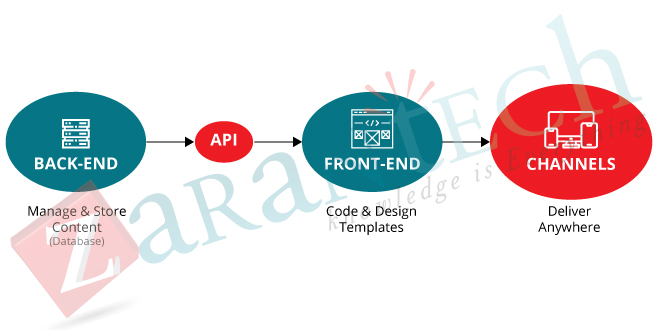
While large ventures may think of applying it, the vendor lock-in connected with Adobe does not bode well for scalability.
That’s because the majority of ventures today choose those solutions which are best-of-breed and also best-of-need philosophy. The complete enterprise technology stack gets build in an agile way, where every new component added is the most effective possible service for the enterprise with given present demands and also restraints. However, in case you choose to select products from the Adobe ecosystem, the need to stick to Adobe becomes crucial. And if you intend to take advantage of any one of its products to its full capability, you may lose on your flexibility of choosing other solutions that could be more suitable to your demands.
In short, once you have decided to go with Adobe and even with just AEM, getting out of it becomes difficult even if you continue adding new moving components to your digital experience stack.
“Drupal encourages enterprises with the flexibility of choosing any type of technology solution that works best as per their respective requirements and integrates with them hassle-free”
However, with Drupal, scalability, expansion, and flexibility have never been an issue. Considering that Drupal is co-created by a whole community of programmers, its function of integrating effortlessly with various other innovation solutions is instilled in its DNA.
The Drupal CMS incorporates easily with numerous enterprise systems, even Adobe, and does not depend on the existence of other Drupal-based solutions to work properly
The potential of decoupled Drupal applications has confirmed it as the best web content manager while allowing other modern technologies to build top to supply increased user-facing functionalities.
The open-source community likewise makes sure that new components and functionalities built on any kind of project get added and made easily available for others to use and work upon.
Fundamentally, Drupal empowers enterprises with the flexibility of choosing any kind of modern technology solution that functions best as per their respective requirements and incorporates them hassle-free.
The Drupal community makes sure to keep the core up-to-date and the platform is always up to speed to collaborate with various other enterprise technologies.
The concern that develops here is whether you intend to entirely switch to Adobe solutions or want to maintain the choice with you where you have the flexibility to select the best solution for your company.
For continuous flexibility and extensibility, it’s recommended to avoid supplier lock-in and pick Drupal.
Drupal or AEM
Here is a list of features in tabular form to carry out the comparison between Drupal and AEM to help you reach the final decision-
Final Words
The final choice between Drupal and AEM will certainly be made by the decision-makers based upon an array of queries around the price of structure, hosting, and maintenance. This involves taking into consideration the associated ROI with both Drupal and AEM to ensure a simple workflow.
The compromise between making Adobe items work together well and also the flexibility to pick the most effective innovation solution according to your needs requires to be very carefully examined.
And also even though both Drupal and AEM, make sure top-notch security and compliance requirements will also need to be taken into account before choosing one over the other.
That’s all for today. If you’re interested to read more articles on this topic, feel free to visit ZaranTech Blog.
At ZaranTech, we also offer a Self-paced video learning program for Workday HCM mentored by certified and experienced subject matter experts. Browse through our course pages for further information.
Happy learning!





 99999999 (Toll Free)
99999999 (Toll Free)  +91 9999999
+91 9999999